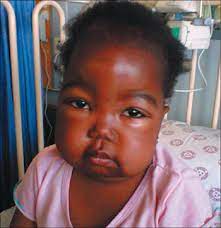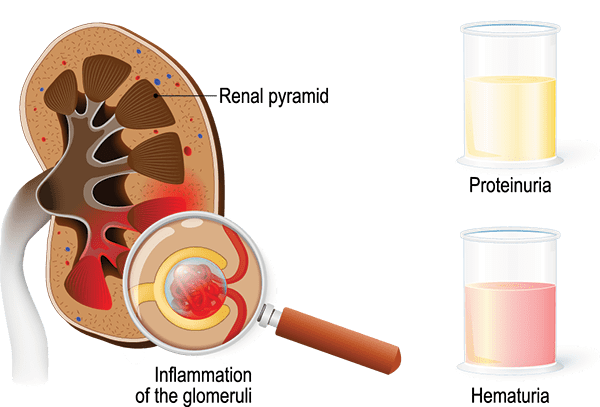Table of Contents
ToggleAcute Glomerulonephritis
Acute glomerulonephritis refers to a specific set of renal diseases in which an immunologic mechanism triggers inflammation and proliferation of glomerular tissue that can result in damage to the basement membrane, mesangium, or capillary endothelium.
OR
Acute glomerulonephritis (GN) is an inflammatory process involving the glomerulus of the kidney.
It is inflammation of the glomerulus.
Acute glomerulonephritis is the most serious and potentially devastating form of the various renal syndromes. Acute glomerulonephritis progresses to chronic glomerulonephritis in about 30% of adults.
This condition usually results in a clinical syndrome consisting of:
- Hematuria
- Proteinuria
- Hypertension
- Renal insufficiency
- Azotemia. (elevated urea and creatinine compounds)
Incidence
Glomerulonephritis can occur at any age; it has a higher incidence in males than in females.
It is common in the young ones and the peak age is 7-10 years. Adolescents and young adults are also commonly affected by the acute glomerulonephritis.
Risk Factors
- Throat infection: Winter or early spring
- Pyoderma : Risk of infection after pyoderma: 25%
- Peak incidence in pre‐school children.
- Clinically apparent GN
occurs in < 2% of children infected with strep infection
Etiology
Acute GN can be due to a primary renal disease or to a systemic disease:
- Its onset is usually secondary to infection of the upper respiratory tract, most commonly caused by group A beta – hemolytic streptococci (post streptococcal infection)
- Malaria parasites (falciparum malariae)
It may be a result of the primary infection elsewhere in the body and be caused by primary staphylococcus, pneumococcus or a virus
It is thought to be due to an abnormal immune reaction to infection
Non streptococcal postinfectious GN may also result from infection by other bacteria, viruses, parasites, or fungi. Bacteria besides group A streptococci that can cause acute GN include the following:
- Staphylococci, Diplococci, Other streptococci, Mycobacteria, Salmonella Tryphosa, Brucella sues, Treponema pallidum, Corynebacterium bovis Actinobacilli e.t.c.
- Viruses e.g. Cytomegalovirus (CMV), coxsackievirus, Epstein-Barr virus (EBV), hepatitis B virus (HBV)
Goodpasture syndrome, a group of diseases affecting the lungs and kidneys.
Rare diseases that inflame blood vessels like granulomatosis with polyangiitis (formerly Wegener’s disease) Granulomatosis with polyangiitis is an uncommon disorder that causes inflammation of the blood vessels in your nose, sinuses, throat, lungs and kidneys. Formerly called Wegener’s granulomatosis, this condition is one of a group of blood vessel disorders called vasculitis. It slows blood flow to some of your organs
Pathophysiology
- Following an occurrence of a streptococcal infection which can either be sore throat or a skin infection, there follows an immune response which is mounted against the streptococcal infection (a specific antibody is produced against streptococci)
- These antibodies destroy the glomerulus because it resembles the antigens of the streptococci.
- This usually occurs 2-3 weeks after the streptococcal infection has taken place. This is characterized by diffused inflammation of the renal cortex (glomeruli) of both kidneys.
- The destruction of the glomerulus permits the red blood cells which is passed in urine as haematuria and pus-cells, RBC casts.
- The destruction further causes reduction in the filtration process
- Reduced ultra filtration stimulates angiotensin I release which in turn is changed to angiotensin II which causes constriction of arterioles, hence increasing total arteriolar resistance, leading to elevation of blood pressure.
- Angiotensin ii release further causes production of aldosterone which causes reabsorption of sodium and water, leading to increase in cardiac output and elevation of blood pressure.

Clinical Features of Acute Glomerulonephritis.
Most often, the patient is a boy, aged 2-14 years, who suddenly develops puffiness of the eyelids and facial edema in the setting of a poststreptococcal infection. The urine is dark and scanty, and the blood pressure may be elevated.
- Onset of symptoms is usually abrupt.
- Nonspecific symptoms include weakness, fever, abdominal pain, and malaise.
- Usually sudden onset with history of sore throat or skin infection, elevated temperature, headache and vomiting.
- Body swellings of the face and lower extremities which tends to become worse in the mornings on waking up with elevation of hypostatic pressure.
- Costovertebral angle tenderness and flank pain likened to renal colic.
- Hematuria is a universal finding, even if it is microscopic. Gross hematuria is reported in 30% of pediatric patients.
- Oliguria
- Edema (peripheral or periorbital) is reported in approximately 85% of pediatric patients; edema may be mild (involving only the face)
- Hypertension often develops. In severe cases, it may be extremely high with severe headache, palpitations, easy fatigability, visual disturbances, vomiting and convulsions (hypertensive encephalopathy).
- Features of cardiac failure
- As the disease progresses, the patient experiences shortness of breath, lethargy and anorexia.
- Headache may occur secondary to hypertension; confusion secondary to malignant hypertension may be seen in as many as 5% of patients.
- Shortness of breath or dyspnea on exertion secondary to heart failure or pulmonary edema; usually uncommon, particularly in children.
- Possible flank pain secondary to stretching of the renal capsule.
- Urinary changes:
- Decreased urinary output-oliguria
- Microscopic haematuria making the urine to appear dark, concentrated and smoky
- Albumin is always present in large amounts
- Casts may be present and can be seen
Clinical Features Summary
Abrupt onset
• Age 4‐ 12 years, M>F
• Latent period : Throat infection : 1‐2 weeks
• Skin infection : 3‐6 weeks
HEMATURIA
• Smoky brown or Cola colored
• Glomerular: dysmorphic RBC, casts in freshly spun urine
PROTEINURIA
• Mild to moderate but nephrotic range is rare
OLIGURIA
• Transient – 50%, Anuria rare
EDEMA : 85%
– Mild : periorbital or pedal
– Severe : hypertension, pleural effusion or ascites
– Adolescents : more likely face and legs
HYPERTENSION: in 80%
– Headache, Somnolence
– Changes in mental status
– Anorexia, Nausea , Convulsions
• HYPERTENSIVE EMERGENCY: 10%
‐ BP > 30% increased for age and sex
‐ Evidence of encephalopathy
‐ Heart failure or pulmonary edema
• AZOTEMIA : varying degrees
• CIRCULATORY CONGESTION : 20%
‐ Dyspnea, Orthopnea
‐ Cough, Tachycardia, Gallop rhythm
‐ CCF, Pulmonary edema
Diagnosis
In the setting of a postinfectious acute nephritis, a latent period of up to 3 weeks occurs before onset of symptoms. However, the latent period may vary; typically 1-2 weeks for post pharyngitis cases and 2-4 weeks for cases of post dermal infection (i.e, pyoderma).
- Onset of nephritis within 1-4 days of streptococcal infection suggests preexisting renal disease.
- Urine: protein, microscopy for pus cells, red blood cells, red blood cell casts, proteins positive, glucose positive.
- Blood: urea and Creatinine levels, and electrolytes
- Ultrasound scan of the kidneys
- Blood pressure
- Throat and skin swab where indicated for C&S
- Blood cultures: Indicated in patients with fever, immunosuppression, intravenous drug use history, indwelling shunts, or catheters.
- Antinuclear antibody (systemic lupus erythematosus)
- Renal biopsy is required for definitive diagnosis, particularly in primary renal diseases. Renal Biopsy is indicated only in;
• Hepatitis B infection
• Nephritis
• Infective endocarditis
• Associated with HSP(Henoch-Schonlein purpura (also known as IgA vasculitis) is a disorder that causes the small blood vessels in your skin, joints, intestines and kidneys to become inflamed and bleed)
Management
- Admission is recommended for patients with anuria, nephrotic syndrome, massive proteinuria, significant hypertension, or pulmonary symptoms.
- Salts (sodium restriction)
- Should not be used in cooking or added to food (salt free diet).
- If oedema is severe, no salt diet should be given.
- Avoid or use with caution any drugs excreted in by the kidney
- The disease is usually self-limiting and the majority of patients may recover spontaneously.
3. Rest:
- The patient should be nursed in a bed rest in a warm well-ventilated room. Ambulation is encouraged in an attempt to reduce oedema and DVT.
4. Dietary regulations (Diet regimen)
- Proteins in the diet, about 20 – 40g of protein daily will be adequate.
- Adequate calorie from carbohydrates and fats ensures minimum protein breakdown.
5. Fluids and electrolytes
- Assess the patient frequently for signs and symptoms of fluid overload.
- Daily weighing of the patient.
- Fluids must be encouraged2-3lires in24hours to increase urinary output.
- An intake and output chart must be kept and the urine examined daily for albumin, RBCs and casts.
- Correction of electrolyte abnormalities (ie, hypocalcemia, hyperkalemia) and acidosis, if present
- Restrict fluids in patients with significant edema.
- Loop diuretics are indicated for patients with nephrotic syndrome (4% of patients) or massive proteinuria.
- Eradicate streptococcal causes by oral antibiotic therapy; Penicillin is indicated in nonallergic patients e.g. Phenoxy methyl penicillin 500mg qid. Child: 10 – 20mg per dose Or Amoxicillin 500mg tds. Child: 15mg/kg per dose. If allergic to penicillin give erythromycin every 6hours. Child: 15mg/kg per dose
6. Prophylactic treatment: penicillin every month or erythromycin to minimize reoccurrence.
7. Agents useful in treating hypertension include calcium channel blockers e.g. nifedipine, amlodipine and nitroprusside sodium.
8. Dialysis incase of;
– Fluid overload
– Severe azotemia
– Electrolyte abnormalities
9. Pulmonary edema
– Aggressive diuresis , Oxygen, Morphine, Ventilation
10. Hyperkalemia
– Oral/iv Restriction, Potassium binding resins
– Nebulized Salbutamol, Glucose insulin
– Calcium infusion
Prognosis
Is always poor with acute glomerulonephritis than with nephritic syndrome
Nursing Diagnosis
- Ineffective breathing pattern related to the pulmonary edema or cardia failure as evidenced by shortness of breath.
- Altered urinary elimination related to decreased bladder capacity or irritation secondary to infection as evidenced by oliguria.
- Excess fluid volume related to a decrease in regulatory mechanisms (renal failure) as evidenced by edema.
- Risk for infection related to a decrease in the immunological defense.
- Imbalanced nutrition less than body requirements related to anorexia, nausea, vomiting.
- Risk for impaired skin integrity related to edema and pruritus.
- Hyperthermia related to the ineffectiveness of thermoregulation secondary to infection as evidenced by a thermometer reading above normal ranges.
- Dialysis in case of;
– Fluid overload
– Severe azotemia
– Electrolyte abnormalities - Pulmonary edema
– Aggressive diuresis , Oxygen, Morphine, Ventilation - Hyperkalemia
– Oral/iv Restriction, Potassium binding resins
– Nebulized Salbutamol, Glucose insulin
– Calcium infusion
Nursing Care Planning and Goals
Nursing care planning goals for a child with acute glomerulonephritis are:
- Excretion of excessive fluid through urination.
- Demonstration of behaviors that would help in excreting excessive fluids in the body.
- Improvement of distended abdominal girth.
- Improvement of respiratory rate.
- Participation and demonstration of various ways to achieve effective tissue perfusion.
Nursing Interventions
- Activity. Bed rest should be maintained until acute symptoms and gross hematuria disappear.
- Prevent infection. The child must be protected from chilling and contact with people with infections.
- Monitor intake and output. Fluid intake and urinary output should be carefully monitored and recorded; special attention is needed to keep the intake within prescribed limits.
- Monitor Blood Pressure. Blood pressure should be monitored regularly using the same arm and a properly fitting cuff.
- Monitor urine characteristics. The urine must be tested regularly for protein and hematuria using dipstick tests.
Evaluation
Goals are met as evidenced by:
- Excretion of excessive fluid through urination.
- Demonstration of behaviors that would help in excreting excessive fluids in the body.
- Improvement of distended abdominal girth.
- Improvement of respiratory rate.
- Participation and demonstration of various ways to achieve effective tissue perfusion.
Prevention
- Early treatment of throat and skin infections
- Avoid overcrowding
- Adequate ventilation in dwellings.
Complications
- Renal failure
- Nephritic syndrome
- Hypertensive encephalopathy
- Heart failure
- Pulmonary edema.
- The patient may have both nephritic syndrome and acute glomerulonephritis and they are called to have nephritic nephritis and the prognosis is poor.


Thanks this was well put